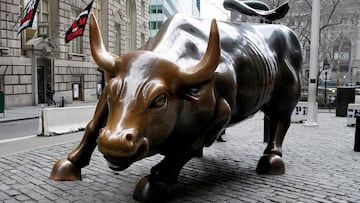What is a bear market and when did the stock market experience the last one?
Positive signs in stock markets have shaken off bear market conditions though they remain below their 2021 highs. What does the term mean?

Markets are coming out of their bear conditions. After a difficult 2022, there have been big rebounds in stocks with the S&P 500 increasing in value by nearly 20% since October 2022. The Nasdaq Composite index, which is tech company focused, has risen by 26% since january.
From the October lows the S&P 500 is now up 21%
— Ben Carlson (@awealthofcs) June 2, 2023
The Nasdaq 100 is up almost 36%
Bear market is over? pic.twitter.com/IOjjCCEqr1
“We’re not in a horrible spot,” James Masserio, co-head of equities for the Americas at Société Général, told the New York Times. “There are recession risks for sure, but we have to see how those materialize over several months and into next year. So technically this is a bull market.”
But what do bear and bull markets signify?
What is a bear market?
Two common terms used by Wall Street are bull and bear markets to talk about the indexes like the S&P 500, the Dow Jones Industrial Average and the Nasdaq Composite rising or falling respectively. A bear market occurs when a market has dropped 20 percent or more from a recent high for a sustained period of time.
According to the Merriam Webster dictionary, the term bear market came first, based on a proverb that cautions against selling “the bear’s skin before one has caught the bear.” The original expression “to sell or buy the bearskin” was quickly shortened to “bear” to talk about a speculator selling stock or the stock itself being sold by a speculator.
Others say that it refers to the way a bear attacks, slashing downward with its claws. A bull on the other hand attacks by charging forward.
Bull markets and bear markets aren’t the same in magnitude or duration. pic.twitter.com/LTEhkKisIL
— Steve Burns (@SJosephBurns) June 5, 2023
Sam Stovall, chief investment strategist at CFRA says that the term “bear” is a reference to the fact that bears retreat to their dens to hibernate, represents the market retreating from its gains.
How many bear markets have there been?
The last time all three indexes were in bear market territory was in March 2020 when covid-19 lockdowns slammed the breaks on the global economy. It was also the shortest bear market on record as the federal government injected trillions of dollars into the economy to stave off complete collapse. Bad market conditions in 2022 also led to some markets being under bear conditions.
Related stories
Prior to that bear market, the US economy had enjoyed an unprecedented bull market fueled by massive injections of liquidity and interest rates near zero in response to the Great Recession. The bear market associated with the bursting of the housing bubble in 2007, lasted for 17 months.
Since 1928 there have been 25 bear markets according to Investopedia. The deepest and longest began in 1929 and lasted until 1932, it was followed by the Great Depression.


